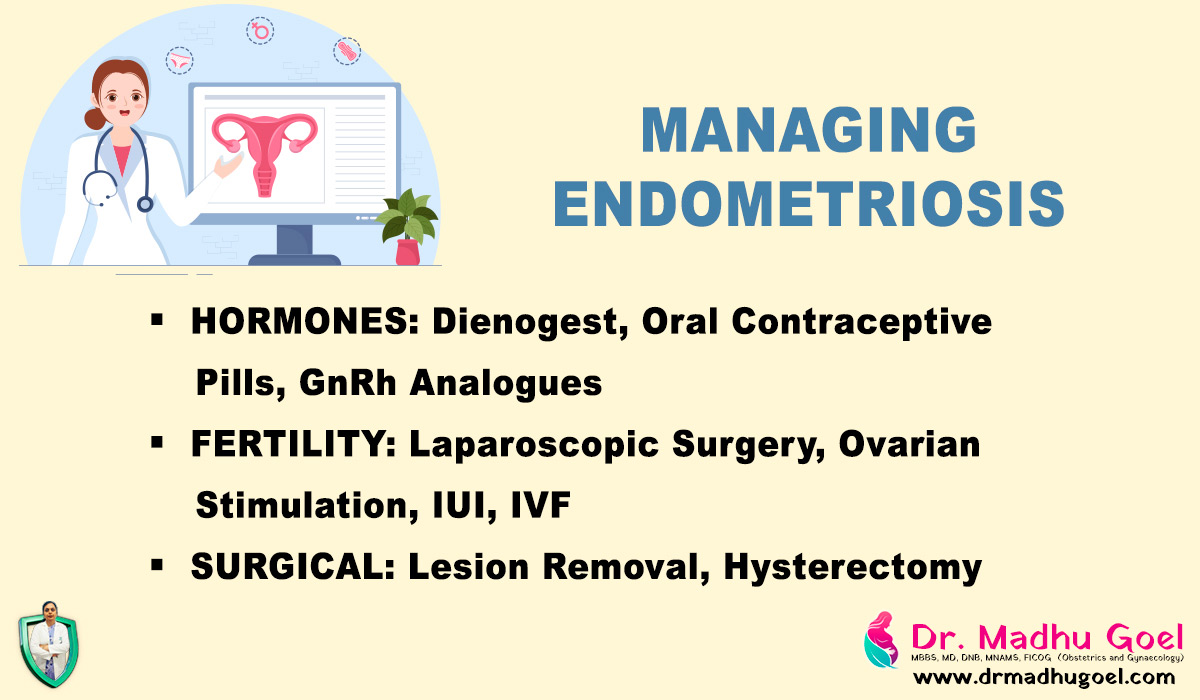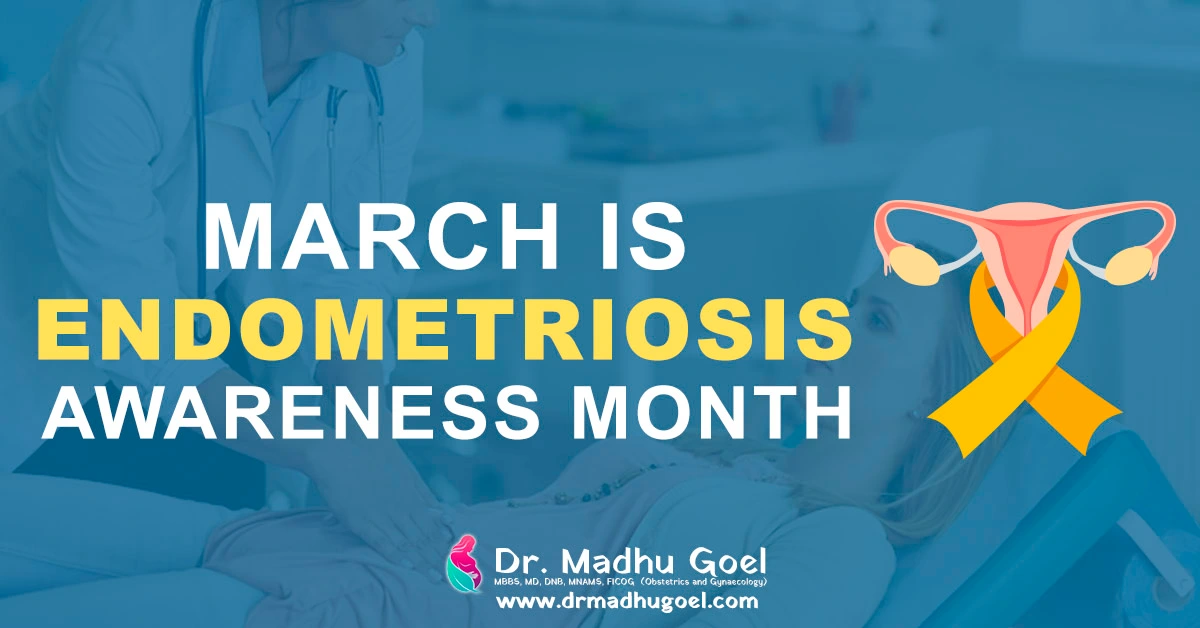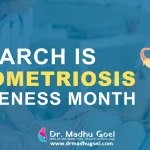Living with Endometriosis: Diagnosis and Treatment Options
Endometriosis. The very word can send shivers down the spine of those who battle it daily. It’s a condition shrouded in mystery, often dismissed as “bad periods.” But for 1 in 10 women, it’s a relentless puzzle. A hidden enemy is causing pain, impacting fertility, and leaving them feeling unheard. Learn about effective endometriosis management and lifestyle changes to improve quality of life.
In our previous blog, we discussed the symptoms and causes of endometriosis. It is a condition where tissue similar to the uterine lining grows outside the uterus. In our blog we emphasized the importance of listening to your body. And seeking medical attention if you suspect endometriosis. Due to lack of definitive test, endometriosis diagnosis is challenging. But, early diagnosis is crucial for better management and treatment outcomes.
March is Endometriosis Awareness Month. A time to break the silence surrounding this condition and empower individuals. Throughout this month, we embark on a journey to demystify endometriosis. This series aims to empower you. Join us as we shine a light on endometriosis, one informative step at a time.
You’re not alone in this fight. Let’s shed light on the complexities of endometriosis. And discover pathways to manage it.
Understanding Endometriosis
1 in 10 women across the world suffer with endometriosis. It happens when endometrial tissue, resembles the lining of uterus, develops outside. This misplaced tissue responds to hormonal changes during the menstrual cycle. It can cause inflammation, pain, and scar tissue formation.
Want to learn more about the causes of endometriosis? Check out our previous blog post! Let’s explore the causes, impact, diagnosis, and treatment options for endometriosis.
How Does Endometriosis Affect You?
Endometriosis can impact your life. Sometimes, it can be a silent thief. Stealing your energy and impacting your daily life. From pelvic pain to fertility struggles, let’s explore how endometriosis can affect you.
- Painful periods: Endometriosis often causes pelvic pain that worsens during menstruation. This pain can be a dull ache or sharp and stabbing. It may even radiate to your lower back and thighs.
- Digestive issues. Endometriosis can disrupt your bowel habits. Leading to diarrhoea, constipation, or painful urination, especially around your period.
- Fatigue and bloating: These symptoms can leave you feeling drained and uncomfortable.
- Infertility concerns: Endometriosis can create scar tissue and inflammation. That makes it harder for pregnancy to occur.
- Emotional impact: Chronic pain, disrupted functions. And potential fertility issues can lead to anxiety and depression. This affects your well-being.
Endometriosis Diagnosis: Methods and Procedures
Unfortunately, there’s no single test for endometriosis diagnosis. Unmasking endometriosis can feel like a detective story. While there’s no single test, combining steps helps your doctor diagnose the condition. Let’s explore in details about endometriosis diagnosis.
- Consult Your Healthcare Professional: The first step is a conversation with your doctor. They’ll delve into your medical history. Asking about your menstrual cycle. Any pain patterns you’ve noticed (especially during periods of intercourse). And any challenges you’ve faced about fertility.
- Pelvic Exam: During a pelvic exam, your doctor will feel your pelvic organs. The medical practitioner wants to assess for tenderness, swelling, or abnormalities.
- Imaging test: Imaging tests like ultrasound or MRI can provide valuable clues. While they can’t diagnose endometriosis, They might reveal the presence of endometriomas. These are cysts filled with blood. Associated with the condition, particularly in the ovaries.
- Laparoscopy for Endometriosis. A laparoscopy might is done if other methods aren’t conclusive. This invasive surgical procedure allows doctor to visualize your pelvic cavity using camera. Laparoscopy for Endometriosis enables them to confirm the presence and location of endometriosis implants.
Endometriosis Treatment Options
While there’s no cure for endometriosis, various treatments can help manage the symptoms. And improve your quality of life. The best treatment plan depends on your individual needs and goals. Such as whether you plan to get pregnant. Here are some common approaches for Endometriosis treatment options

Hormonal Therapies
Hormonal therapies are often the first-line treatment for endometriosis. Dienogest, Oral Contraceptive Pills (OCPs), and Gonadotropin-Releasing Hormone (GnRH) Analogues are commonly used to manage symptoms by reducing estrogen levels, which in turn reduces the growth and shedding of endometrial-like tissue. These medications can help alleviate pain, reduce the size of endometriotic lesions, and slow the progression of the disease. However, they are not a permanent cure and symptoms may return once treatment is stopped.
Fertility Preservation
For women with endometriosis who wish to preserve fertility, laparoscopic surgery is often recommended. This minimally invasive procedure involves removing endometriosis lesions, scar tissue, and adhesions. By restoring normal pelvic anatomy and function, surgery can improve fertility and increase the chances of natural conception.
Assisted Reproductive Techniques
In cases where endometriosis has led to infertility, assisted reproductive techniques (ART) such as ovarian stimulation, intrauterine insemination (IUI), and in vitro fertilization (IVF) may be recommended. These techniques can help overcome infertility by bypassing the fallopian tubes and directly facilitating fertilization.
Surgical Options
In severe cases of endometriosis, or when other treatments have not been effective, surgical options may be considered. Lesion removal surgery aims to remove endometriotic lesions and scar tissue, while hysterectomy involves the removal of the uterus. These surgeries are usually reserved for cases where symptoms are severe and impacting quality of life, or when fertility is no longer desired.
Important to Remember:
- Early diagnosis and treatment are crucial for managing endometriosis.
- Open communication with your doctor is essential. To determine the best treatment plan for you.
- Support groups can provide valuable information and emotional support for women with endometriosis.
By working with your doctor and understanding your treatment options. You can manage endometriosis and improve your overall well-being.
Also Read:
- Living with Endometriosis: Diagnosis and Treatment Options
- Beyond Pain: Managing Endometriosis for a Balanced Life
- Endometriosis Diet: Healthy Lifestyle Habits for Managing Endometriosis
FAQ: Endometriosis Management
Q: How is endometriosis diagnosed?
A: Endometriosis is diagnoses is through a combination of factors. Including medical history, physical exam, imaging (ultrasound, MRI), and laparoscopy.
Q: What are the treatment options for endometriosis?
A: Endometriosis Treatment Options include hormonal therapy (birth control pills, therapy). Pain management (NSAIDs, opioids), and surgery (laparoscopy).
Q: Is there a cure for endometriosis?
A: While no definitive cure exists for endometriosis. Several endometriosis treatment options are available. This help reduce symptoms and enhance quality of life.
Conclusion
While endometriosis management presents diagnostic challenges, don’t be discouraged. You can reach a diagnosis and explore endometriosis treatment options. A combination of Endometriosis diagnosis tools and a proactive healthcare professional. Remember, you’re not alone. There are various treatment modalities like hormonal therapy, pain management, and surgery. This will help pain management for Endometriosis and improve your quality of life. If you suspect endometriosis, advocate for yourself and seek professional guidance. Together, we can turn the tide on endometriosis. And empower individuals to live fulfilling lives.
Our Digital Imprints:
Dr. Madhu Goel
Senior Consultant Obstetrician and Gynaecologist
Director, Fortis La Femme
I am passionate about women’s
health. With expertise in managing high-risk pregnancies,
infertility, and various gynaecological issues, I strive to provide
compassionate care. I am committed to ensuring the well-being of my patients.
Follow me for insights and updates on women’s health.
Get Connected to my Newsletter
“Health
Hub”: Women’s Health & Wellness
Connect with me: Instagram | Facebook | LinkedIn




